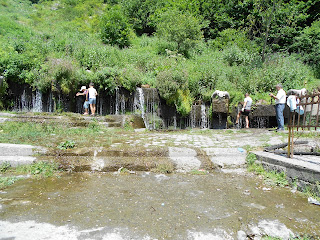Georgians, like a lot of Europeans, get married twice –
once in an “official” civil ceremony and once in the church. Our friend, Niko, was married several years
ago in a civil ceremony. Since his wife,
Zhenia, became pregnant, however, she’s been thinking about getting married in
the church so their baby can be christened/baptized in the church. Niko's been trying to make
that happen, but he's been divorced before, something the Eastern Orthodox
Church does not take lightly or kindly. So he's been talking to the Bishop of
Tbilisi to get the Georgian equivalent of an annulment so he can make a church
wedding happen. I say "talking to" when "financially
negotiating" might be a better description. The Bishop decides Niko can
get married in the Church if he makes a rather sizable "donation" to
the Patriarchate (somewhere in the neighborhood of $2000). But, and here's the
catch: he must get married TODAY. Seems that once he annuls the first marriage,
Niko would be living in sin (despite the civil ceremony) so he has to get
married immediately or move out of the apartment he shares with his wife and
parents. Niko obviously decides to get married today.
So, since we're on the way to work while all this is happening, we do a U-turn and
head back to Tbilisi while Niko makes phone calls. The only thing scarier than
Niko's driving is Niko's driving while he's on the phone. His first call is not
to his wife, as one would expect, but to his father to find out if the
"donation" is reasonable. After determining that $2k is steep but
reasonable (considering Niko has no choice in the matter), Niko calls the
Bishop and agrees to get married today. Note he still hasn't called his wife.
Niko then calls his designated best man so he can leave
work early for the wedding. He still hasn't called his wife. As an afterthought, Niko says to us, "You guys want to come to my wedding?" We say, sure, why not? There's nothing good on TV tonight anyway. THEN he calls Zhenia to break the news to her. She
isn't thrilled, but what can she do? This is all her idea. Now, Zhenia's
parents live in Moscow; they're not coming to the wedding. Niko's mother and
sister are in NYC at the sister's house. They're not coming, either.
As we drop off Niko at his flat, Zhenia comes tearing
down the steps (well, as much as a woman in her 7th month of pregnancy can
"tear"). She has to go to the hairdresser. She gives Niko the stink
eye, but what can he do? So off she goes -- zoom. Or more accurately, --
waddle. We Americans meet in a local bar
to have a beer and some lunch and wait for the announcement. Did I mention that
Niko doesn't know exactly WHERE they're getting married or WHEN? Other than
somewhere in Tbilisi today.
Eventually, we get a call that the wedding will be in 10
minutes at the oldest church in Tbilisi, the Basilica of St. Mary. Fortunately
and coincidentally, we're IN the bar right next to the church, so we chug our
beers and head over for the ceremony.
The ceremony is typical Eastern Orthodox. The women wear
scarves (makes you wonder why Zhenia had to get her hair done), and the maid of
honor has a piece of material wrapped around her waist to simulate a skirt
since she's in pants. The only men wearing ties are the Americans. Everyone else is in jeans and sweaters. The church is cold, so the wedding party
wears coats. A quick ceremony and they're married.
We congratulate the slightly breathless and annoyed
couple, and head back to the bar to celebrate.
Niko tells us that there will be a “small reception party” at a local
restaurant sometime tonight. He’ll call
us.
The call comes at 7:30pm:
“Hey, where are you? We’re
celebrating at the Fortuna. Nothing big,
just me and Zhenia and some friends.
Come on down.” Not wanting to be
rude, and because there’s no beer in my fridge, we head to the Fortuna
Restaurant for a “small party.” I must
be the stupidest man in Georgia.
His “small party” is a full-blown supra for approximately
30 people. Which means there’s enough
food and alcohol for 60 people. We
certainly don’t want to offend the overwhelmed and slightly inebriated groom
and his lovely and flustered bride, so we dive right in to the whole supra
scene. On a school night. When we have a very important briefing the
next day to the US Deputy Assistant Secretary of Defense for Eurasia. I said I must be the stupidest man in
Georgia. We finally escape from the
restaurant four hours later with the party still in full flight and the bride
sleeping peacefully in an overstuffed chair in the corner covered by a
tablecloth.
Just another typically Georgian event, but one I’m glad I
got to experience. Thanks for reading.


.JPG)























































